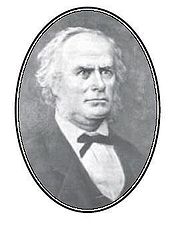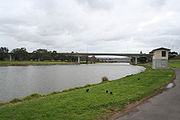
James Harrison (engineer)
Encyclopedia

Australia
Australia , officially the Commonwealth of Australia, is a country in the Southern Hemisphere comprising the mainland of the Australian continent, the island of Tasmania, and numerous smaller islands in the Indian and Pacific Oceans. It is the world's sixth-largest country by total area...
newspaper printer, journalist, politician, and pioneer in the field of mechanical refrigeration
Refrigeration
Refrigeration is a process in which work is done to move heat from one location to another. This work is traditionally done by mechanical work, but can also be done by magnetism, laser or other means...
.
Early life
James Harrison was born at St Johns (near Renton), DunbartonshireDunbartonshire
Dunbartonshire or the County of Dumbarton is a lieutenancy area and registration county in the west central Lowlands of Scotland lying to the north of the River Clyde. Until 1975 it was a county used as a primary unit of local government with its county town and administrative centre at the town...
, Scotland, the son of a fisherman. He trained as a printing apprentice in Glasgow
Glasgow
Glasgow is the largest city in Scotland and third most populous in the United Kingdom. The city is situated on the River Clyde in the country's west central lowlands...
and worked in London
London
London is the capital city of :England and the :United Kingdom, the largest metropolitan area in the United Kingdom, and the largest urban zone in the European Union by most measures. Located on the River Thames, London has been a major settlement for two millennia, its history going back to its...
before emigrating to Sydney, Australia in 1837 to set up a printing press for the English company Tegg & Co. Moving to Melbourne
Melbourne
Melbourne is the capital and most populous city in the state of Victoria, and the second most populous city in Australia. The Melbourne City Centre is the hub of the greater metropolitan area and the Census statistical division—of which "Melbourne" is the common name. As of June 2009, the greater...
in 1839 he found employment with John Pascoe Fawkner
John Pascoe Fawkner
John Pascoe Fawkner was an early pioneer, businessman and politician of Melbourne, Victoria, Australia. In 1835 he financed a party of free settlers from Van Diemen's Land , to sail to the mainland in his ship, Enterprize...
as a compositor and later editor on Fawkner's Port Phillip Patriot. When Fawkner acquired a new press, Harrison offered him 30 pounds for the original old press to start Geelong's first newspaper. The first weekly edition of the Geelong Advertiser
Geelong Advertiser
The Geelong Advertiser is a daily newspaper servicing Geelong, Victoria, Australia, the Bellarine Peninsula and surrounding areas. The Geelong Advertiser is the oldest newspaper title in Victoria and the second oldest in Australia, and was first published on 21 November 1840. The newspaper is...
appeared 21 November 1840: edited by 'James Harrison and printed and published for John Pascoe Fawkner (sole proprietor) by William Watkins...'. By November 1842, Harrison became sole owner.....
Harrison was a member of Geelong's first town council in 1850 and represented Geelong and Geelong West in the Victorian Legislative Assembly
Victorian Legislative Assembly
The Victorian Legislative Assembly is the lower house of the Parliament of Victoria in Australia. Together with the Victorian Legislative Council, the upper house, it sits in Parliament House in the state capital, Melbourne.-History:...
in 1859-60. As an editor he was an early advocate for tariff protection which later he brought to prominence when he was editor of The Age
The Age
The Age is a daily broadsheet newspaper, which has been published in Melbourne, Australia since 1854. Owned and published by Fairfax Media, The Age primarily serves Victoria, but is also available for purchase in Tasmania, the Australian Capital Territory and border regions of South Australia and...
under the proprietorship of David Syme
David Syme
David Syme was a Scottish-Australian newspaper proprietor of The Age and regarded as "the father of protection in Australia" who had immense influence in the Government of Victoria.-Early life and family:...
. But his rise ceased abruptly in 1854 after a controversial libel suit was brought against him by the Crown Prosecutor
Crown Prosecutor
Crown Prosecutors are the public prosecutors in the legal system of Australia.Crown Prosecutors represent the Crown in right of the Commonwealth and in right of each State or Territory in criminal proceedings. Crown Prosecutors are appointed not elected and not public servants; they are private...
George Mackay whose evident drunkenness on duty Harrison had editorially deplored. The jury brought in a verdict for Mackay with Harrison to pay £800 damages. In 1862, although his assets were worth £22,000, he had to sell the Advertiser to escape bankruptcy.
It was while he owned this paper from 1842 to 1862 that his interest in refrigeration
Refrigeration
Refrigeration is a process in which work is done to move heat from one location to another. This work is traditionally done by mechanical work, but can also be done by magnetism, laser or other means...
and ice-making began to develop. Whilst cleaning movable type
Movable type
Movable type is the system of printing and typography that uses movable components to reproduce the elements of a document ....
with ether
Ether
Ethers are a class of organic compounds that contain an ether group — an oxygen atom connected to two alkyl or aryl groups — of general formula R–O–R'. A typical example is the solvent and anesthetic diethyl ether, commonly referred to simply as "ether"...
, he noticed that the evaporating fluid would leave the metal type cold to the touch.
Pioneer
Harrison's first mechanical ice-making machine began operation in 1851 on the banks of the Barwon RiverBarwon River (Victoria)
The Barwon River rises in the Otway Ranges of Victoria, Australia, runs through Winchelsea and the city of Geelong, where it is joined by the Moorabool River, and enters the sea at Barwon Heads after passing through Lake Connewarre on the Bellarine Peninsula...
at Rocky Point in Geelong. His first commercial ice-making machine followed in 1854, and his patent for an ether vapor-compression refrigeration
Vapor-compression refrigeration
Vapor-compression refrigeration is one of the many refrigeration cycles available for use. It has been and is the most widely used method for air-conditioning of large public buildings, offices, private residences, hotels, hospitals, theaters, restaurants and automobiles...
system was granted in 1855. This novel system used a compressor to force the refrigeration gas to pass through a condenser, where it cooled down and liquefied. The liquefied gas then circulated through the refrigeration coils and vaporised again, cooling down the surrounding system. The machine employed a 5 m (16 ft.) flywheel and produced 3000 kilograms (6,613.9 lb) of ice per day.
Though Harrison had commercial success establishing a second ice company back in Sydney in 1860, he later entered the debate of how to compete against the American advantage of unrefrigerated beef
Beef
Beef is the culinary name for meat from bovines, especially domestic cattle. Beef can be harvested from cows, bulls, heifers or steers. It is one of the principal meats used in the cuisine of the Middle East , Australia, Argentina, Brazil, Europe and the United States, and is also important in...
sales to the United Kingdom
United Kingdom
The United Kingdom of Great Britain and Northern IrelandIn the United Kingdom and Dependencies, other languages have been officially recognised as legitimate autochthonous languages under the European Charter for Regional or Minority Languages...
. He wrote Fresh Meat frozen and packed as if for a voyage, so that the refrigerating process may be continued for any required period, and in 1873 prepared the sailing ship Norfolk for an experimental beef shipment to the United Kingdom. His choice of a cold room system instead of installing a refrigeration system upon the ship itself proved disastrous when the ice was consumed faster than expected. The experiment failed, ruining public confidence in refrigerated meat at that time. He returned to journalism, becoming editor of the Melbourne Age in 1867.
Harrison continued to work on refrigeration, with the emphasis on producing a system that would allow the export of meat from Australia to England. At the Melbourne Exhibition of 1872-73, Harrison showed his proposal, where meat would be frozen in the refrigeration plant and then stored in an insulated "cold bank" on board the ship.
An experiment was launched in July 1873 with ice used to keep the "cold bank" temperature down and the meat frozen. But the experiment ended in disaster when there was not enough ice to complete the journey. The meat thawed and had to be thrown overboard. Harrison was ruined and again went back to journalism at The Age
The Age
The Age is a daily broadsheet newspaper, which has been published in Melbourne, Australia since 1854. Owned and published by Fairfax Media, The Age primarily serves Victoria, but is also available for purchase in Tasmania, the Australian Capital Territory and border regions of South Australia and...
. His journalism included Scientific Gossip, signed "Oedipus" (mythical solver of the Sphinx's riddle), reported local scientific news, discussed Darwinism and other international controversies of the day, invited correspondence, and included a section on current patents.
Harrison's work helped in the continued development of refrigeration and it wasn't long before meat and other products were successfully transported through the tropics using it.
Harrison returned to Geelong in 1892 and died at his Point Henry
Moolap, Victoria
Moolap is a residential and industrial suburb of Geelong, Victoria, Australia. The name Moolap is derived from an Aboriginal word for nearby Point Henry, moo-laa, thought to mean 'men gathering to go fishing'. Moolap in Aboriginal tongue means "Shady Place" ....
home in 1893.
Legacy

The Australian Institute of Refrigeration Air Conditioning and Heating most distinguished award is the James Harrison Medal.
The James Harrison bridge spanning the Barwon River
Barwon River (Victoria)
The Barwon River rises in the Otway Ranges of Victoria, Australia, runs through Winchelsea and the city of Geelong, where it is joined by the Moorabool River, and enters the sea at Barwon Heads after passing through Lake Connewarre on the Bellarine Peninsula...
in Geelong is named in his honor.
Further reading
- Lang, William Rawson James Harrison, Pioneering Genius. Neptune Press, Newtown, 1982
- Morrison, Elizabeth James Harrison: Inventor and Science Journalist Australasian Science vol 19 no. 10, 1998
- W. R. Brownhill The History of Geelong and Corio Bay. Melbourne 1955.
- R. T. B. McKenzie Father of Refrigeration, Refrigeration Journal, Sept 1956.
See also
- Thomas Sutcliffe MortThomas Sutcliffe MortThomas Sutcliffe Mort was an Australian industrialist responsible for improving refrigeration of meat. He was renowned for speculation in the local pastoral industry as well as industrial activities such as his Ice-Works in Sydney's Darling Harbour and dry dock and engineering works at...
- another Australian refrigeration inventor - Jacob PerkinsJacob PerkinsJacob Perkins was an Anglo-American inventor, mechanical engineer and physicist. Born in Newburyport, Massachusetts, Perkins was apprenticed to a goldsmith...
- American inventor who patented an ether cycle machine in 1836. - Alexander Twining - an American contemporary who patented a similar machine in 1850 and 1853.
- John GorrieJohn GorrieJohn Gorrie , physician, scientist, inventor, and humanitarian, is considered the father of refrigeration and air conditioning. He was born on the Island of Nevis to Scottish parents on October 3, 1802, and spent his childhood in South Carolina...
- American physician and inventor, another pioneer of refrigeration.

